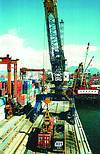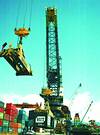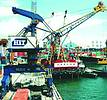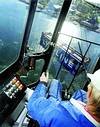

Crane control has come a long way in the last few years, with ‘intelligent’ drives with on-board software giving improved low-speed control and therefore the ability to limit swaying of the load as well as reduced energy consumption and reduced maintenance. It may sound too good to be true, but all of these benefits stem from more sophisticated control across the speed range, without energy wastage and without the shock loads that cause load swaying and heavy wear and tear on bearings, switchgear and motors.
For both OEM cranes and for the very buoyant retrofit market, the trend is now towards distributed control - that means with the processing being as close as possible to the motors ie in the drives themselves. This greatly simplifies the wiring of both new cranes and retrofits and often cuts one major cost factor out of the equation - the PLC. In addition, the use of a fieldbus network such as Interbus, DeviceNet or CTNet, simplifies communication between drives, reduces wiring costs and remote I/O and makes functions such as digital lock between drives very straightforward.
Software can also be used to provide a traditional 'feel' to the joystick controls, so that crane drivers immediately feel at home with a new or retrofitted crane.
Traditionally, slewing control has been achieved by applying counter-torque to the slip-ring motor and operators are used to controlling the crane in this way to minimise swing of the load. The slip-ring motor gives good motor torque for acceleration and deceleration and it is possible to coast when the controller is moved to zero.
However, this method of control is very poor at low speeds, with sudden steps in torque between resistor steps wasting a lot of energy and causing excessive wear and tear. Nevertheless, modern systems need to mimic this method of control to give the driver immediate confidence and familiarity with the controls.

Port of Tonsberg
A typical example can be seen in the 50 tonne crane, built by A/S Stålproducter of Molde in Norway for the port of Tonsberg, 100 km south of Oslo. For the handling of containers, this crane has an operating radius of 11-30 m and a hoist speed of 11,5 m/min. All four drives for the hoist, boom control, slewing and track drives were Unidrive universal AC drives from Control Techniques, with the 30 kW Unidrive for the slewing control having additional on-board processing running Control Techniques slewing control software. This provides the driver with control over both the speed and the motor torque.
Speed control is important for accurate positioning at low speed. It also provides compensation for the wind forces on the load. Torque control is crucial for controlling the sway. In this way, the driver is always able to anticipate the movement of the load and to compensate for it. By bringing the controller back to zero, the movement is effectively coasting, which gives a major dampening effect on the swaying of the load.
This crane also featured energy saving, with the 90 kW boom drive running in regenerative mode when the boom is lowered, feeding power back to the mains supply and eliminating the need for large and costly resistor banks.

Retrofitting
Dockside cranes - indeed, cranes of all types including gantry cranes and warehouse cranes - all have one thing in common. The electrical systems invariably have a shorter lifespan than the very substantial mechanical parts.
There is a point where the time and cost of maintenance of the crane's drives becomes uneconomic and downtime is seriously affecting the operation of the dockyard or the factory.
This is why the market for the retrofitting of crane drives is very substantial, but, for the user, it is a potential minefield.
"We have seen that the issues of control are very specialised," says Rudi van der Merwe, Marketing Manager of Control Techniques SA. "All too often, when replacing the slip-ring motors with a modern drive system, the results can be very disappointing - and, in extreme cases, using a conventional speed-controlled system, it is virtually impossible to control the swaying of the load.
Without the complete confidence of the operator, it will not be possible to operate the crane to its optimum capacity, safely and predictably. The options are to go for a PLC-controlled system or one, such as Unidrive, where the processing is localised.
But, there are other issues too, van der Merwe continues:
* Has the supplier the experience to install and provide the necessary ongoing technical support?
* Are spare parts readily available from stock?
* Are there issues relating to the way in which the drives operate? And can they be improved?
* Are there changes that must be made to conform to current safety legislation? Is the supplier fully aware of what these are?
When designing a design system for retrofitting, the supplier has to ensure that it is suitable for installing in situ in the existing environment, with the appropriate level of protection against damp, spray or dust. They must also demonstrate a level of understanding about how a crane is used in practice, with the need to recreate the same characteristic 'feeling' on the controller.
With regard to the maximum capacity of the crane, this is only valid provided that the controls for the crane movements are tuned in such a way that the driver is able to control this maximum load easily and safely. Otherwise the crane is effectively de-rated to the maximum load that is safe to handle.

Special features
When a crane is ready for retrofitting, it is worthwhile considering other features that can be incorporated at the same time. Productivity can be considerably enhanced with the facility for high-speed empty hook operation - typically, three times base speed.
A sophisticated power cable reeler tension control - again a software option that can be built into a Control Techniques Unidrive - soon pays for itself in reduced downtime by preventing cable fatigue and breaks.
With a long travel gantry crane, absolute skew elimination is achieved with digital lock function for the twin motors - again a software function - and standard application macros for axis limit and brake control simplifies the commissioning of Unidrives.
Hong Kong case study
Control Techniques recently won a major Hong Kong contract for dynamic braking systems on harbour-side jib cranes at the Kwai Chung container terminal, the world's busiest container port. The project is for three rail-mounted jib cranes operated by Hutchison International Terminals (HIT), the world's largest independently owned container terminal operator.
HIT owns and operates the Kwai Chung Container Terminals 4,6 and 7, has a joint venture to operate two berths at Terminal 8 and serves over 30 international shipping lines along its 10 berths.
"We had a hard battle against formidable opposition from Japanese, German and American competitors, but finally won the contract because the system would be built and supported locally," says Mr H.B. Tee, of Control Techniques China. "We were also able to provide a very good reference site for a similar scheme in Shanghai and HIT were very impressed, both with the drives and with the support we could provide."
Control Techniques has supplied a total of three sets of six 'Unidrive' universal AC digital variable speed drives. These include nine 132 kW drives, six 110 kW drives and three small 2,2 kW drives. The main hoist is controlled by three paralleled size 5 Unidrives, a 110 kW Unidrive controls the slew/gantry, a 45 kW Unidrive is used for the luff and three small Unidrives control the travel. Each system is PLC controlled with Interbus communications directly with the drives via their plug-in Interbus applications modules (UD73). The drives provide speed control, torque control.
The changeover of motor maps and digital lock for the hoist were written in a DPL program and saved in UD73 plug-in module. Dynamic braking of hoist was done through braking resistors.
"To have HIT's endorsement of our drives is a significant success for Control Techniques," explains Tee. The world's port operators look to HIT as a leader in technology and this contract will have a major impact on our future growth in this market in Chinese coast and river ports."
Hutchison International Terminals has made a massive investment to create an operation of unrivalled efficiency in Hong Kong. It has 32 quay cranes, 24 rail-mounted gantry cranes, 12 overhead bridge cranes and a fully computerised port management system.
Control Techniques
(011) 462 1740
| Tel: | +27 11 462 1740 |
| Email: | [email protected] |
| www: | www.controltechniques.com |
| Articles: | More information and articles about Nidec Control Techniques |

© Technews Publishing (Pty) Ltd | All Rights Reserved